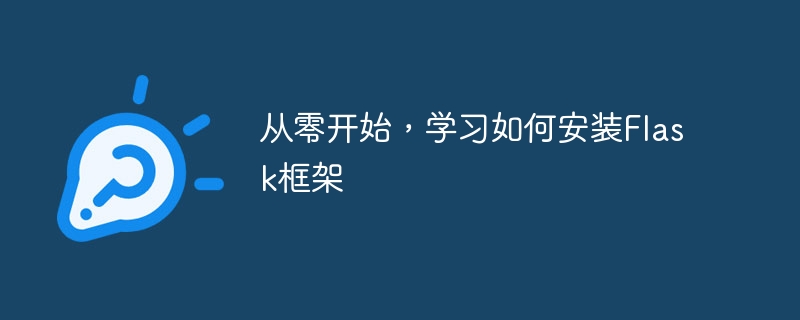

Start from scratch, learn how to install the Flask framework, you need specific code examples
Flask is a lightweight web framework written in Python, it is very simple and easy to use , suitable for beginners to start learning. This article will detail how to install and use the Flask framework from scratch and provide specific code examples.
Step one: Install Python and pip
Before installing Flask, you need to install Python and pip first. You can download and install the latest version of Python from the official Python website (https://www.python.org/downloads/). After the installation is complete, open the command line tool and enter the following command to verify whether Python and pip are installed successfully:
python --version pip --version
If the version numbers of Python and pip can be displayed correctly, the installation is successful.
Step 2: Install Flask
The Flask framework is installed using pip. Just run the following command in the command line to install the latest version of Flask:
pip install flask
After the installation is completed, You can use the following command to verify whether Flask is installed successfully:
python -c "import flask; print(flask.__version__)"
If the version number of Flask can be displayed correctly, it means the installation is successful.
Step 3: Create a simple Flask application
Below we will create a simple Flask application and add some basic routing and view functions.
First, create a Python file in the project root directory and name it app.py.
from flask import Flask
# 创建Flask应用
app = Flask(__name__)
# 定义一个路由和视图函数
@app.route('/')
def index():
return 'Hello, Flask!'
# 运行Flask应用
if __name__ == '__main__':
app.run()In the above code, we imported the Flask class and created a Flask application. Then a view function index with route '/' is defined. When the root path is accessed, the view function will be called and the string Hello, Flask!## will be returned. #. Finally, run the Flask application through app.run().
Running the Flask application is very simple, just run
python app.py in the command line. Then visit http://localhost:5000 in the browser. If Hello, Flask! can be displayed correctly, it means that the Flask application runs successfully.
In the Flask application, you can add more routing and view functions as needed.
from flask import Flask
app = Flask(__name__)
@app.route('/')
def index():
return 'Hello, Flask!'
@app.route('/about')
def about():
return 'This is about page!'
@app.route('/user/<username>')
def user(username):
return 'Hello, %s!' % username
if __name__ == '__main__':
app.run()/about is accessed, the about view function is called and the string This is about page! is returned. When accessing the path /user/, the parameter in the access path will be passed to the user view function and the characters will be returned. StringHello, %s!. Among them, %s will be replaced by the actual parameters.
Through the above steps, we successfully installed the Flask framework and created a simple Flask application. We learned how to create routes and view functions and test them by running a Flask application. I hope this article can help you get started with the Flask framework and lay the foundation for your future web development.
The above is the detailed content of Learn the basics of installing the Flask framework. For more information, please follow other related articles on the PHP Chinese website!




